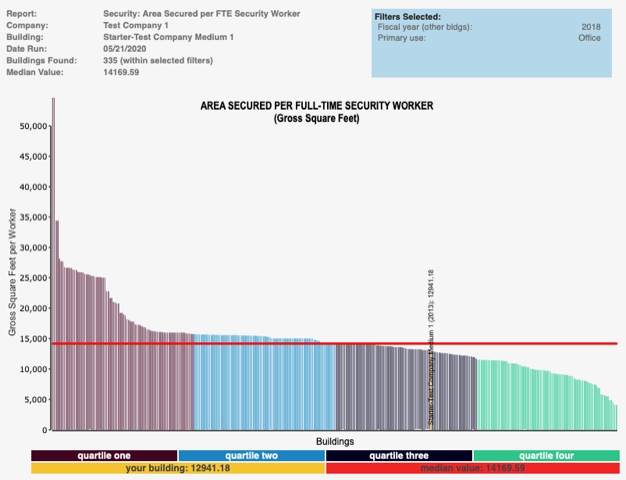May 2020 — This month’s article reviews how you can use benchmarking to assure that you have the appropriate staffing levels to secure your facility. If the numbers look unfavorable, you even can use benchmarking to evaluate a bid for contracting out services.
In these days of COVID-19 and heightened security concerns to control access to the facilities, most organizations are reassessing their security plans and staffing levels. Clearly this pandemic will cause a reevaluation of the process and access points for your facilities. It is highly likely that your existing security services contractor will be tasked with additional staffing services or an updated staffing plan.
Since labor for security services makes up about 90% of security costs, you budget might be tight for adding more staff. If so, you instead may want to consider additional monitors or other electronic solutions. Still, you can use benchmarking data to determine if the security contractor is either adequately staffed or proposing a reasonable staffing plan for the required security services.
What is needed for this evaluation of security staffing? Most benchmarking surveys will collect their staffing data on a full-time equivalent (FTE) annual basis. Depending upon the level of detail, the survey could ask for:
- Total staff
- Staffing by internal and contract workers
Our experience shows that most security staffing level questions come down to an evaluation of total security staff. For security services, nearly all of the services will be provided by contractor, so in most cases total staff and staffing by contract workers will be same value. There normally will be some internal staff to manage the security contract but it is minimal compared to the total contract cost.
Determining and keeping the appropriate security staffing levels is probably one of the more critical decisions that facilities managers and the senior leadership team can make. If you are understaffed, then there are risks to both the facility and the occupants. Entrances may not be properly monitored, routine patrols may not occur at the appropriate frequency, background checks may not be completed, etc. If you are overstaffed, the workforce is not being used effectively, and resources that should be used for more productive purposes will be wasted.
We have an example to illustrate how easy and valuable the process should be and how you can avoid the problem of too many or too few staff. This approach allows you obtain the key output report of staffing per securable area. All that is really needed is:
- Total number of security FTEs by internal and contract
- Total gross area of the facility
Figure 1 shows the staffing level performance for our building compared to that of other office facilities. Disregarding a couple of outliers at the left end of the chart, the overall performance ranges from about 28,000 GSF to 5,000 GSF secured per person. About eighty percent of the group is in the range of 17,000 to and 11,000 GSF secured per person. Our facility is near the middle of the third quartile with a value of 12,491 GSF secured per person.

Figure 1 – Area Secured per Person
Filters: Type of facility: office
Provided courtesy of FM BENCHMARKING
Our building is shown in the third quartile with a relatively high staffing rate. This would indicate an opportunity for improvement but with the current pandemic it is unlikely that any security staff will be reduced. One aspect to effectively securing the facility and minimizing unauthorized intrusions, thereby reducing costs, is to keep the number of entry points to the minimum. With COVID-19 it is assumed that all entry points will need to be staffed to perform routine checks on the employee health before granting access.
The facility’s cost also is in the third quartile, which is not surprising since labor comprised most of security costs. This example clearly shows the power of benchmarking to support our staffing level decision-making.